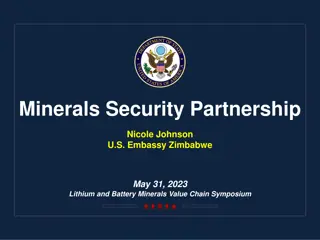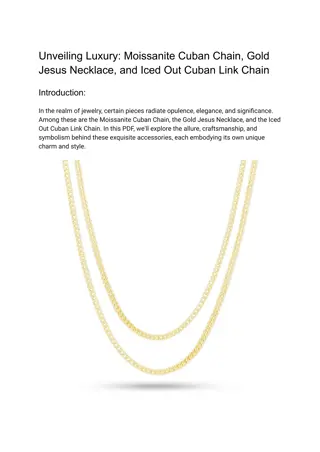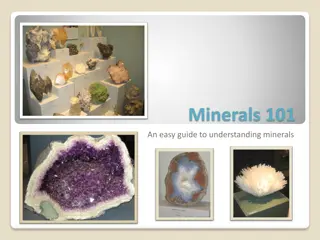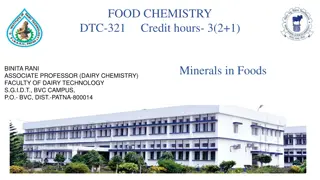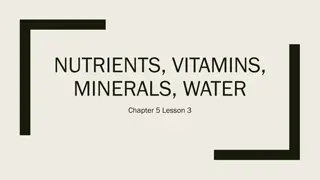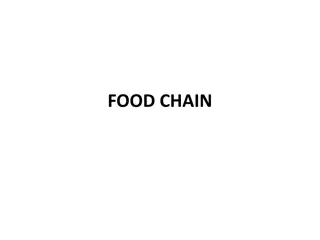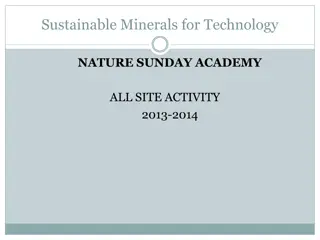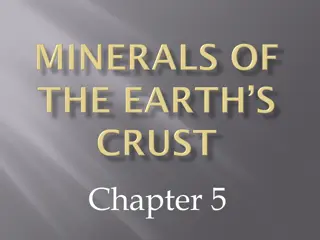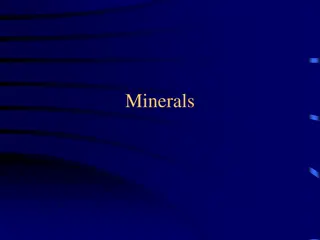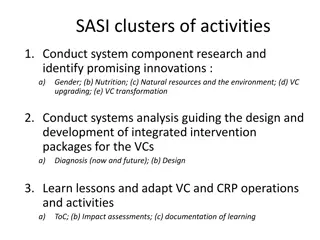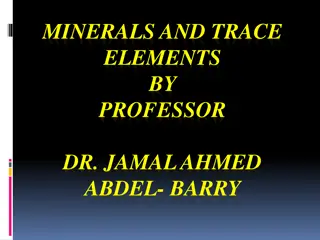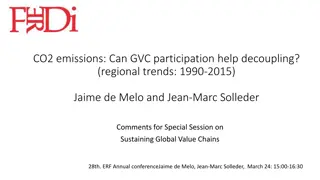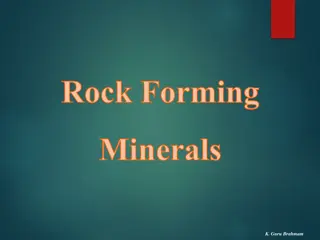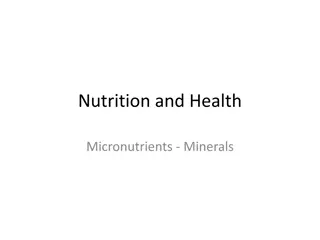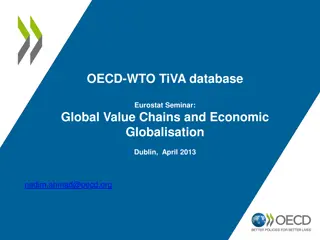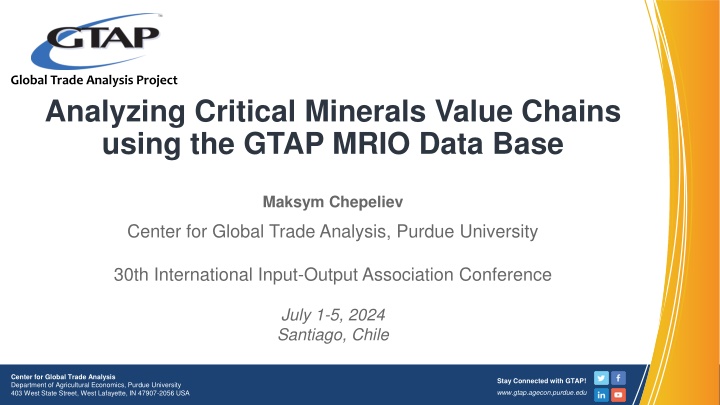
Analyzing Critical Minerals Value Chains Using GTAP MRIO Data
Motivated by the need for sustainable material consumption patterns, this project explores the incorporation of critical minerals in the Circular Economy transition. By addressing limitations in existing modeling approaches, it aims to represent future energy transitions and the demand for essential minerals like nickel, platinum group metals, and rare earths.
Download Presentation

Please find below an Image/Link to download the presentation.
The content on the website is provided AS IS for your information and personal use only. It may not be sold, licensed, or shared on other websites without obtaining consent from the author. If you encounter any issues during the download, it is possible that the publisher has removed the file from their server.
You are allowed to download the files provided on this website for personal or commercial use, subject to the condition that they are used lawfully. All files are the property of their respective owners.
The content on the website is provided AS IS for your information and personal use only. It may not be sold, licensed, or shared on other websites without obtaining consent from the author.
E N D
Presentation Transcript
Global Trade Analysis Project Analyzing Critical Minerals Value Chains using the GTAP MRIO Data Base Maksym Chepeliev Center for Global Trade Analysis, Purdue University 30th International Input-Output Association Conference July 1-5, 2024 Santiago, Chile Center for Global Trade Analysis Department of Agricultural Economics, Purdue University 403 West State Street, West Lafayette, IN 47907-2056 USA Stay Connected with GTAP! www.gtap.agecon.purdue.edu
Outline 1. Motivation 2. GTAP Data Base v11 3. GTAP circular economy database 3. Incorporating critical minerals and downstream sectors 4. Sample application: demand for minerals under mitigation scenarios 5. Conclusions and next steps 2
Need for decoupling material use from economic growth Current material use patterns are projected to put tremendous pressure on the Earth s ecosystem Changes in incomes and population together with a global convergence in material use patterns could result in over 2.5 times increase in global material demand by 2050 (Steffen et al., 2015). These trends would represent a major challenge for the climate mitigation and other conservation efforts. The need to move toward a more sustainable material consumption patterns is widely recognized and is promoted within a Circular Economy (CE) concept. Modelling of the Circular Economy transition requires an explicit representation of the primary and secondary production activities Represent country-specific production volumes of primary and secondary activities. Distinguish between corresponding supply and cost structures, e.g. for steel, aluminum, copper, other metals, plastics. Such representation is not available in the standard GTAP Data Base. 3
Previous efforts at modeling circularity have a number of limitations A number of studies have represented the Circular Economy splits within the global CGE or IO modeling framework MRIO assessments based on the EXIOBASE (e.g. Tisserant et al., 2017; Wiebe et al., 2019). CGE-based assessment focusing on selected sector/commodity (e.g. Winning et al., 2017 for the case of steel). GTAP-based assessments with a more detailed splits, e.g. OECD (2019), Dellink (2020), Bibas et al. (2021). Selected limitations of the existing approaches: Are based on the EXIOBASE cost structures and output values, which do not always correspond to the actual observations (see e.g. Winning et al., 2017). Focus on selected commodities or specific aggregate regional representations. Are not consistently updated over time. Not publicly available. 4
Representation of the future energy transition requires new sectoral details (both upstream and downstream) Achieving climate mitigation targets will require an unprecedented expansion in renewable infrastructure and technologies Such transition will lead to the growing demand for critical minerals, such as nickel, platinum group metals, zinc, rare earths, etc., which are essential inputs for the development of renewable energy systems (Tokimatsu et al., 2018). It is estimated that within the pathways toward limiting global warming below 1.5oC, the demand for critical minerals could increase between 2 and 267 times by 2050 depending on the mineral (Wang et al., 2022). Apart from pure supply and logistical constraints, the rising demand for critical minerals is also associated with national security aspects and is prone to generate geopolitical frictions (Vakulchuk et al., 2022). It is important to have the analytical capacity for the analysis of future energy transition scenarios with an explicit representation of the critical minerals value chains (both upstream and downstream). 5
Key features of the GTAP 11 Five reference years 2004, 2007, 2011, 2014, 2017 141 countries + 19 aggregate regions 20 new and 39 updated national IOTs have been incorporated Individual countries cover 99% of the world GDP and 96% of its population Format consistent with the new standard GTAP model GAMS containers, and distribution available for classic GTAP 7
Evolution of the GTAP Data Base Regions and sectors in GTAP since 1993 180 160 160 141 140 Regions Sectors 140 134 120 113 100 87 80 66 65 65 57 57 57 57 57 60 50 45 37 37 37 40 30 24 15 20 0 GTAP 1 (1993) GTAP 2 (1994) GTAP 3 (1996) GTAP 4 (1998) GTAP 5 (2001) GTAP 6 (2005) GTAP 7 (2008) GTAP 8.1 (2012) GTAP 9a (2016) GTAP 10 (2019) GTAP 11 (2022) 8
GTAP 11: A major expansion of coverage in Africa Afghanistan Algeria Central African Republic Chad Comoros The Congo Republic The Democratic Republic of the Congo Equatorial Guinea Eswatini Gabon Haiti Iraq Lebanon Mali Niger Palestine Serbia Sudan Syria Uzbekistan. 9
Commodity coverage in GTAP 11 Paddy rice Coal Wood products Electrical eqpt. Communication Wheat Oil Pulp, paper etc. Energy intensive Oth. Manufacturing Other mach. & eqpt. Financial services Other cereals Gas Refined oil etc. Other manu. Insurance Vegetables & fruits Agriculture etc. Other minerals Pharmaceuticals Electricity Real estate Oil seeds Red meat Other chemicals Gas distribution Other bus. services Processed food Sugar cane & beet White meat Rubber & plastics Water Recreation etc. Plant-based fibers Vegetable oils Other mineral prod. Construction Public Admin. Services Other crops Dairy products Ferrous metals W & R trade Education Beef etc. Processed rice Other metals Hotels, rests. etc. Health Poultry, pork, etc. Refined sugar Metal products Warehousing etc. Dwellings Raw milk Other food Mot. vehicles & parts Land transport Wool etc. Beverages & tobacco Other trp. eqpt. Sea transport Forestry Textiles Electronic eqpt. Air transport Fishing Clothing Leather products 10
GTAP-CE v11 introduces additional sectoral splits No. GTAP New sector Description 1 nmn Non-metallic minerals mining 2 mio Mining of iron ores 3 mao Mining of aluminum ores 4 mco Mining of copper ores 5 moo Mining of other ores 6 rbr Rubber products 7 plp Plastic products primary 8 pls Plastic products secondary 9 plr Recycling - plastics oxt 76 GTAP-Power 11 Data Base sectors are disaggregated into 99 sectors rpp Cement 10 11 12 13 14 15 16 17 18 19 20 21 22 23 24 cem nmx isp iss ris isc app aps ral cpp cps rcp mpp mps rom nfc nfr nmm Other mineral products Iron and steel primary Iron and steel secondary Recycling - iron and steel Iron and steel casting Aluminum primary Aluminum secondary Recycling - aluminum Copper primary Copper secondary Recycling - copper Other metals primary Other metals secondary Recycling - other metals Non-ferrous metals casting Nitrogen fertilizer i_s These sectoral splits provide a complete coverage of the CBAM commodities (except hydrogen) nfm 25 26 pfr Phosphorus fertilizer 27 28 29 chm kfr xch Potassium fertilizer Other chemicals 13
The database construction process utilizes a variety of data sources fdsfsa Data: Volumes of primary and secondary production, volumes of waste, recycling rates, bilateral trade data for sectors or interest. Data sources: USGS, UNIDO, BACI, UNEP IRP MFA, PRODCOM, World Steel, Jambeck et al. (2015), Plastics Europe, Veolia, multiple country-specific data sources (for plastic recycling rates), World Bank, International Fertilizer Association (IFA), FAO. Construction of the production targets using volume and price data. Data: Volumes of primary and secondary production, volumes of waste, recycling rates, bilateral trade data for sectors or interest. Data sources: USGS, UNIDO, BACI, UNEP IRP MFA, PRODCOM, World Steel, Jambeck et al. (2015), Plastics Europe, Veolia, multiple country-specific data sources (for plastic recycling rates), World Bank, International Fertilizer Association (IFA), FAO. Construction of the production targets using volume and price data. (1) Data preparation (output splits) Data: Disaggregated individual country input-output tables (USA, Korea, Japan, Canada), EXIOBASE, specific cost structure assumptions. Construction of the cost structure targets. (2) Data preparation (supply/use splits) Data: GTAP 11 Power Data Base, data inputs from Steps 1 and 2. Reconciliation of the production targets, supply/use structures and trade data for disaggregated SAMs extracted from the GTAP. (3) Targets reconciliation Data: Split targets from Step 3. GTAP Data Base split using SPLITCOM. (4) Database split Data: Disaggregated database from Step 4. Incorporation of the energy and emission flows for disaggregated sectors. Compilation of the final database. (5) Construction of the final database 14
GTAP-CE v11: Sectoral composition Global primary vs secondary output values in 2017 2500 45% 41.2% 40% 38.9% 2000 35% Share of secondary output, % Value of output, bn USD 30% 29.4% 1500 25% 24.3% 20% 18.6% 1000 15% 10% 500 5% 0 0% Plastic Iron and steel Aluminum Copper Other non-ferrous metals Primary Secondary Share of secondary production, % 15
Incorporating Critical Minerals into the GTAP Data Base 16
Energy transition will increase demand for selected minerals Source: IEA (2024) https://www.iea.org/reports/the-role-of-critical-minerals-in-clean-energy-transitions/executive-summary 17
Renewable technologies will also demand metals Steel material intensity, kg/Kw Aluminum material intensity, kg/Kw 700 20 18 600 16 500 14 12 400 10 300 8 200 6 4 100 2 0 0 Solar PV (c-Si) Wind, mineral Wind, offshore, mineral (DD- EESG) Concentrated solar power coal (conv pul) gas (CC) Solar PV (c-Si) Wind, mineral (DD-EESG) Wind, offshore, mineral (DD- EESG) Concentrated solar power coal (conv pul) gas (CC) (DD-EESG) Source: Liang et al. (2022), Carrara et al. (2020), Watari et al. (2019), Deetman et al. (2021), Wang et al. (2022). Data collections have been kindly shared by colleagues from PNNL. 18
Additional sectoral splits are being incorporated to represent mining and refining of selected minerals Data collections from USGS and other sources: Covering selected ores and metals. Ore mining, production trade flows. Price data across metals and ores. Primary and production split data. Ore output in 2017, bn USD 45 40 35 30 metal bilateral 25 and 20 15 10 5 0 secondary 19
Should primary and recycling activities be considered for (selected) metals? Recycling rates across metals (global-average), % 70 65 65 65 60 Caveats: 52 52 50 46 Country-specific data on recycling rates is often missing. 40 37.5 40 37 35 33 33 32 30 22.5 Recycling rates might vary substantially across sectors. 22 19 17.5 20 10 0.5 0 Source: https://www.resourcepanel.org/reports/recycling-rates-metals 20
Downstream sectoral splits are also considered Currently considered sectoral/commodity splits include: Solar panels. Wind turbines. Electric vehicles split out of GTAP motor vehicles ( mvh ) sector (potentially differentiated by type commercial, residential). Batteries (differentiated by type). 21
Exploratory application: Demand for minerals under climate mitigation scenarios 22
Methodology: Linking CGE and global energy system models Source: Chepeliev, Giannakidis, Kanudia, and van der Mensbrugghe (2024). Implications of the Net Zero Transition Scenarios on SDG Indicators: Linking Global Energy System, CGE and Atmospheric Source-receptor Models , Springer Nature, Lecture Notes in Energy (forthcoming). 23
KYNESIS model is run till 2100 with imposed carbon budgets Knowledge-based Investigation of Energy System Scenarios (KINESYS) is a multi-region inter-temporal PE model of the global energy system, which is developed using the TIMES model generator of IEA-ETSAP (Kanudia 2023). KINESYS integrates assumptions across fuel, technology, and policy landscapes to explore how the entire energy system responds to different incentives and constraints. For the electric power sector, demand is modeled through seasonal and daily time slices. On the technological side, the model represents several negative emission technologies, including direct air capture, bioenergy with carbon capture and storage (BECCS) and hydrogen BECCS (H2 BECCS). No. Scenario Budget period Budget, Gt Scenario description 2oC-consistent scenario with carbon budget imposed over the 2020-2070 period 2C-2070 2020-2070 1310 1. 2oC-consistent scenario with carbon budget imposed over the 2020-2100 period 2C-2100 2020-2100 1310 2. 1.5oC-consistent scenario with carbon budget imposed over the 2020-2070 period 1.5C-2070 2020-2070 460 3. 1.5oC -consistent scenario with carbon budget imposed over the 2020-2100 period 1.5C-2100 2020-2100 460 4. 24
Installed capacities of renewable generation technologies grow significantly over time Installed capacity by technologies, GW (<1.5C 2070 scenario) Installed capacity by technologies, GW (<1.5C 2100 scenario) 40000 60000 35000 50000 30000 Gas (CCS) Coal (CCS) Wind Solar Oil Nuclear Hydro Gas Coal Gas (CCS) Coal (CCS) Wind Solar Oil Nuclear Hydro Gas Coal 40000 25000 30000 20000 15000 20000 10000 10000 5000 0 0 25
Low carbon transition substantially increases demand for selected minerals Change in demand for selected metals due to new generation technologies and related infrastructure under the 1.5-C 2070 scenario Copper demand, Million tonnes Nickel demand, Million tonnes 7 x 3 times 120 x 14 times 6 100 5 80 4 x 2 times 60 x 6 times 3 40 2 20 1 0 0 2019 2050 2100 2019 Wind 2050 2100 Wind Solar Nuclear Coal Natural gas Solar Nuclear Coal Natural gas Chromium demand, Million tonnes Zink demand, Million tonnes 80 10 x 16 times x 5 times 8 60 x 3 times 6 40 x 7 times 4 20 2 0 0 2019 2050 2100 2019 Wind 2050 2100 Solar Nuclear Coal Natural gas 26 Wind Solar Nuclear Coal Natural gas
Conclusions and next steps GTAP circular economy database v11: Preliminary version is available and currently under testing (is planned to be publicly shared later this year). Next steps: Refining the set upstream and downstream sectoral splits. Data collection on the cost structures of the downstream sectors. Incorporation of the critical minerals and downstream sectoral splits to the GTAP- CE v11 Data Base. Implementation of the constructed database in the ongoing set of projects focusing on climate mitigation policies. 27
Global Trade Analysis Project Thank you! Questions/Comments? mchepeli@purdue.edu Center for Global Trade Analysis Department of Agricultural Economics, Purdue University 403 West State Street, West Lafayette, IN 47907-2056 USA Stay Connected with GTAP! www.gtap.agecon.purdue.edu

